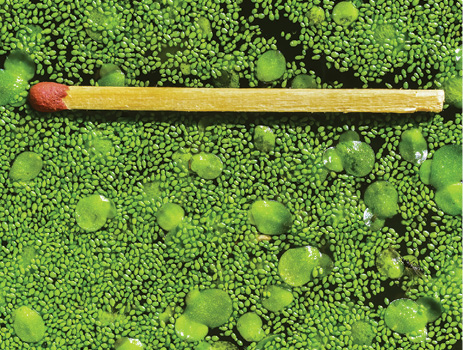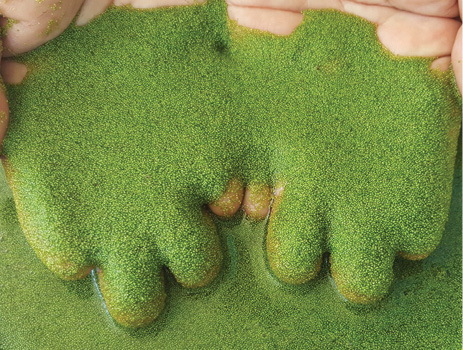Watermeal | Wolffia spp.
Floating | Native



Watermeal is a group of native plants and contains several species. Individual plants are a single, tiny, oval leaf (frond) with no roots. It is often found together with other floating or emergent plants.
Often mistaken for a “scum” of planktonic algae, watermeal can be differentiated by its gritty texture when rubbed between the fingers. It looks and feels like green cornmeal. These species are the world’s smallest flowering plants. The flowers are miniscule and rarely observed. Fragmentation and budding are the most common form of reproduction.
Watermeal is often present in shallow, weedy shorelines of ponds but can become problematic under certain conditions. Excessive nutrients in small, wind-protected ponds often lead to problems.
Management Value
Even though watermeal is eaten by ducks and other species, its ability to quickly cover the water’s surface and eliminate nearly all light penetration prohibits any value it may provide. Eradicate on first sign of excessive growth.
Recommended Controls
Option 1: Flumioxazin (4.0-pound formulation). For each gallon of water, mix 0.2 ounce flumioxazin and 1.3 ounces non-ionic surfactant. Use a buffering agent when mixing with water with pH greater than 7.0. Spray to wet all plants. Do not exceed annual herbicide rate limits as stated on the product label.
Option 2: Diquat (3.73-pound formulation). For each gallon of water, mix 1.28 ounces diquat and 1.3 ounces non-ionic surfactant. Spray to wet all plants. Do not exceed annual herbicide rate limits as stated on the product label.
Multiple herbicide applications may be necessary to eradicate plants.
Read and follow all chemical label instructions, especially the section on the use of personal protection equipment.

The information given here is for educational purposes only. References to commercial products, trade names, or suppliers are made with the understanding that no endorsement is implied and that no discrimination against other products or suppliers is intended.
Publication 3735-47 (POD-11-23)
By Wes Neal, PhD, Extension/Research Professor, Wildlife, Fisheries, and Aquaculture; Dennis Riecke, Fisheries Coordinator, Mississippi Department of Wildlife, Fisheries, and Parks; and Gray Turnage, PhD, Assistant Research/Extension Professor, GeoSystems Research Institute.
The Mississippi State University Extension Service is working to ensure all web content is accessible to all users. If you need assistance accessing any of our content, please email the webteam or call 662-325-2262.



